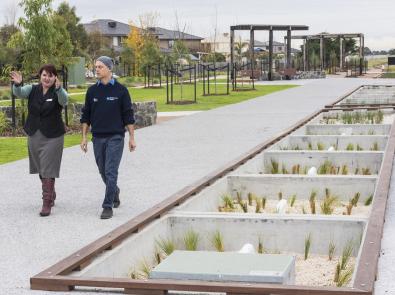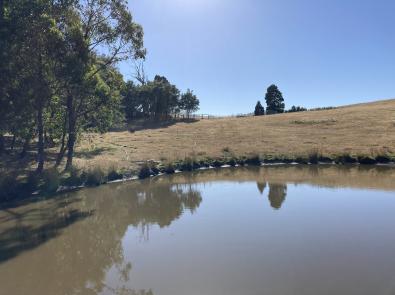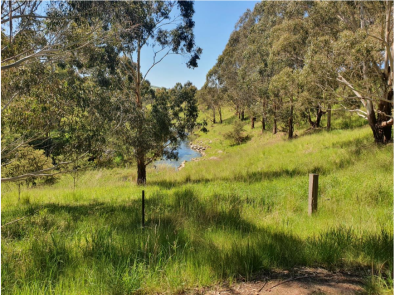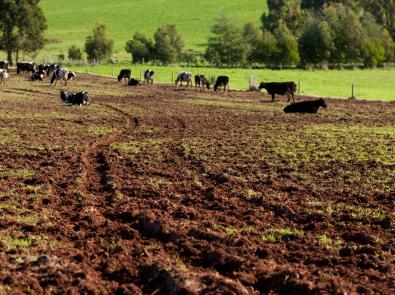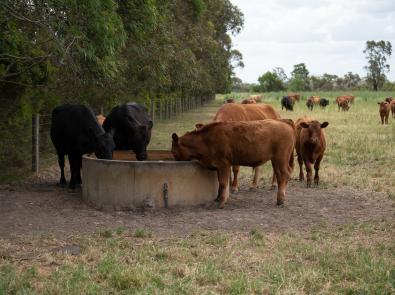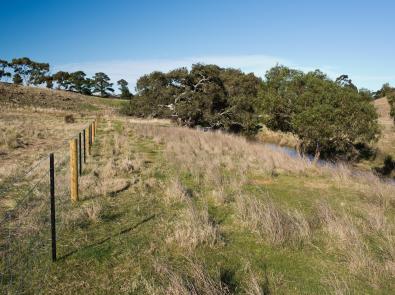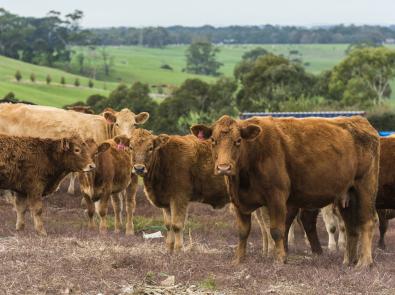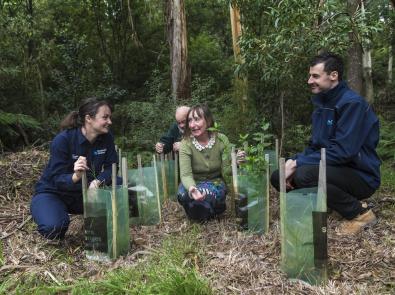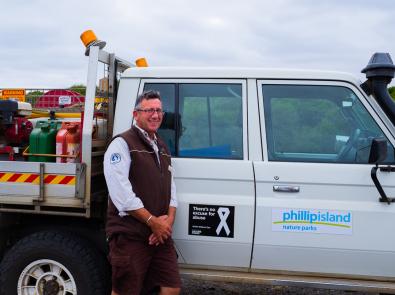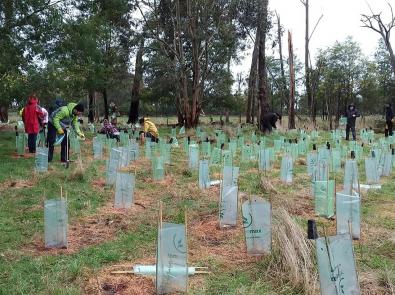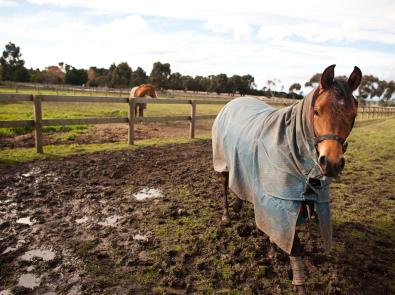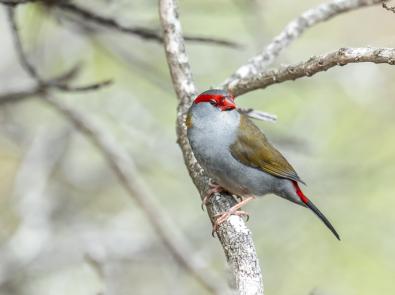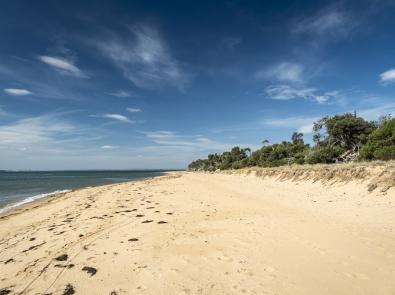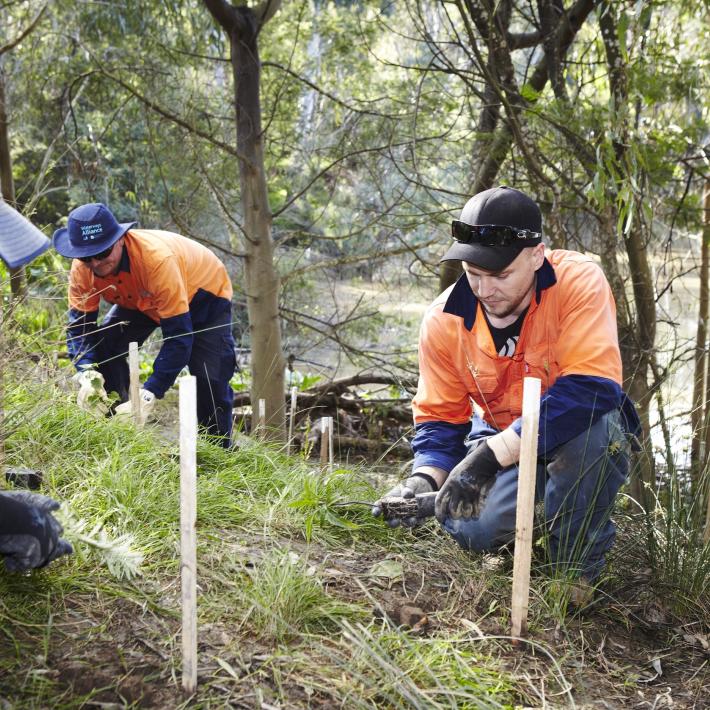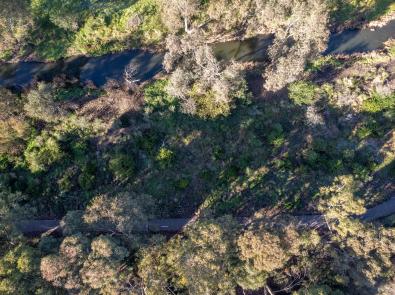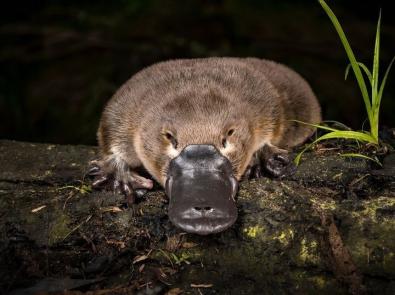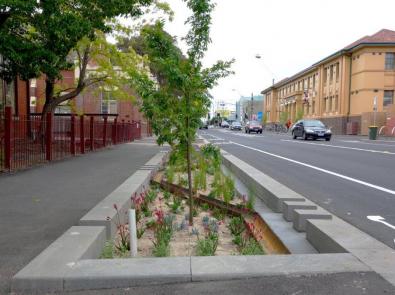Over the years Melbourne Water has fostered meaningful partnerships with our customers and community through existing grants in waterway and stormwater management.
The following projects showcase the broad variety of partnerships that Melbourne Water supports, and the community and environmental benefits.
An indicative list of the types of projects we can help fund is included in our Program Guidelines.
Rural Land Incentives
Achieving best practice through excluding livestock from waterways and farm dams
- Project overview
-
Ken has worked with Melbourne Water for several years undertaking several projects to improve the health of waterways that flow into a Deep Creek. Ken's property is 41ha and has large tracts of remnant vegetation, there are a four dams on this property, one has been fenced out through the program.
Ken constructed approx. 875m of permanent electric rural fencing to exclude stock from the dams, drainage lines and remnant vegetation, helping to improve water quality and maintain dams integrity. Wet paddocks were fenced separately using landclass fencing to help manage soil and reduce pugging and erosion.
An off Stream Stock Watering System was installed consisting of a header tank, polypipe and stock troughs so that livestock don’t need to access the waterway or dams directly to drink. A reticulated water supply helps to protect water quality for the farm, and now allows Ken to manage the livestock and rotationally graze the animals around the farm with ease as water supply is no longer limiting. Rotational grazing also helps to improve groundcover and helps to reduce soil erosion. Water is pumped from a dam to the header tank which then is gravity fed to the troughs. A gravity reticulated system provides a controlled water flow to 4 troughs reducing water consumption.
Project included the engagement of a contractor to plant 720 plants to reduce erosion, increase biodiversity and to help with filtering of sediment and nutrients from the drainage lines and dams.
Whole farm planning and mapping
Amount funded: $1,545.50
- Project overview
-
Landholders Kate and Peter moved to the property from the city and don't have any farming experience however are really keen to learn and adopt best practices. They decided to continue with a remarkable history of collaboration with Melbourne Water, where the whole property creek frontage was fenced.
The property was lacking internal/landclass fencing and there was only a small farm dam for stock watering which was pumped directly from Deep Creek. After the site assessment the project assessor recommended a 10 year action plan to enhance the waterway health and biodiversity protection. The plan included:
- Farm mapping: Land class fencing of environmentally sensitive and water sensitive areas, paddock locations
- Stocking rates (dry sheep equivalent) based on an average year identified
- A farm water supply and budget (how much water is required, where is it coming from i.e. tanks/creek, reticulation system mapped including header tank size and pipe size and location)
The whole farm plan enabled Kate and Peter to understand their properties physical features and how they would like to progress their revegetation and waterway protection away from the waterway and to set up paddocks based on slope and soil type which helps to reduce soil erosion and nutrient runoff. Landholders are already discussing with Melbourne Water future funding to implement actions and activities recommended in the whole farm plan.
Improving farm management and water runoff
Amount funded: $227,337 since 2010
- Project overview
-
Glenn and Wendy manage a dairy farm on steep, sloping land in Gippsland. This means that when it rains, sediment and nutrients from land management activities can quickly wash into waterways. Over the last seven years, Glenn and Wendy, with assistance from Melbourne Water, have worked to improve on-farm management practices and the quality of runoff leaving their property.
The steep landscape on Glenn and Wendy’s property created areas which were difficult to manage and where they needed to exclude stock. Funding from Melbourne Water allowed them to fence these areas and revegetate gullies. This has improved stock management and allowed good ground cover to grow which minimises the risk of erosion and helps filter sediment and nutrients before they enter our waterways.
Glenn and Wendy also fenced off waterways and dams to improve bank stability, water quality and stock health. By removing some dams, they could direct excess surface water into waterways as environmental flow. In addition, they prevented stock from accessing other smaller dams until revegetation can establish. These dams now act as sediment traps and help improve downstream water quality.
One wet year, Glenn and many other farmers experienced landslips in the area. Giant Gippsland Earthworms, which are a threatened species were found at the bottom of the landslip. The earthworms need specific soil moisture conditions to survive, so Glenn’s farm took part in a revegetation trial to avoid planting around the earthworm colonies, or in areas upslope of them to retain soil moisture. The farmers used local plant species and carefully considered planting locations, providing further vegetation while avoiding impacts to the worm colonies.
Improving the Health of Deep Creek
- Project overview
-
Farmer David reckons he brokered a good deal when he swapped a hectare of problematic grazing land for a more efficient and reliable stock watering system.
David describes the area he fenced off as a weeping swamp spring that begins ‘bubbling up’ in June and remains wet until November. The land is prone to pugging and compaction (signs that the soil structure has been damaged) which prevents good pasture growth. Many animal health issues are also associated with grazing boggy areas, including becoming stuck or cast, and conditions such as mastitis in cattle, footrot in sheep and mud fever in horses.
An obstacle to fencing off the site, however, was that it contained a spring-fed dam that David’s cattle accessed for water. Fortunately, he had heard about the LCLW program via his neighbour and contacted Melbourne Water to see whether funding was available to install a new watering system.
The Melbourne Water Assessor who visited the property, confirmed that the swamp, which drains into Deep Creek, qualified for LCLW funding. If David fenced off and protected the swamp, Melbourne Water would pay for all the fencing materials and plants to revegetate the site. Melbourne Water would also pay for most of the costs of installing a watering system which, in David’s case, included two header tanks, three troughs, a pump and around one kilometre of poly piping.
David accepted the offer and has not looked back, saying that being able to move water around the property has transformed his whole-farm management.
“I’ve got four new paddocks, and a clean and reliable source of water,” he explains. “I can rotationally graze, which means better pasture, and on top of all that, I am keeping my stock safe.”
His view of the swamp, which is teeming with new growth as a result of being fenced off from stock and revegetated, has also been transformed. No longer a management headache, it is now a valuable farm asset. “It has purpose because it provides my stock with clean water, and it’s also very attractive. It has gone from having no biodiversity to having amazing growth - the gum trees are extraordinary.”
Improving the Health of Lang Lang River
- Project overview
-
If you manage land along the Lang Lang River, you may be eligible for funding to improve your soil and nutrient management practices and boost farm productivity.
Participation in the LCLW Program has helped Robyn and Denis turn their plans for a more productive and easily managed property into reality.
The couple began working with Melbourne Water in 2004, when they were running their 93 hectare property, which is extremely hilly as a dairy farm. Cows and calves were regularly wandering into the Lang Lang River and, unable to negotiate the steep banks, ended up in the neighbour’s place. Some even drowned.
Melbourne Water helped them fence off and revegetate their entire river frontage, which made managing the farm far easier. In 2010, encouraged by their success, Robyn and Denis partnered with Melbourne Water again, embarking on a major farm restructure to fence off and revegetate their drainage lines and gullies. This included building a new laneway to avoid crossing a gully that was impassable in winter with either a tractor or an All Terrain Vehicle.
The last of the gullies were planted out in 2019 and the couple, who are now running red Angus beef cattle, are thrilled with the outcomes. Robyn appreciates having a much safer and more efficient work environment, while Denis loves the shade and the shelter from the harsh westerlies offered by the plantations.
Other benefits include less pugging (“great for growing grass”), reduced erosion and the feel-good factor of seeing clean water running into the river. The trees “make the place look a lot tidier” and are encouraging a multitude of birds to the area, including a newly-arrived pair of wedge-tailed eagles.
The couple are responsible for ongoing maintenance, including weed control, but Denis says that “the program works both ways and we have no qualms about having to do that”. Nor is he worried about the land that is no longer available for grazing.
“We may have lost a few acres, but we have more than made up for it in other ways,” he says. “We’ve gained shade, shelter and warmth for the cattle, animals don’t get lost in the river and we don’t risk getting bogged in the gully.”
“We would not be here today with the improvements we have made to the farm if it wasn’t for the help offered by Melbourne Water,” says Robyn. “We had the big picture, but we could never have afforded to do it without them.”
Improving the Health of Emu Creek
- Project overview
-
Long-term beef farmers, Leal and Tim have seen much change on and around their property. Among the most positive, is the condition of Emu Creek, which – thanks to the couple’s hard work and perseverance – has gone from being a bare slash in the landscape to a 4.5 kilometre ribbon of shade, shelter and native habitat.
Their ‘incredible adventure’ began in the 1990s when they decided to fence off all the Emu Creek frontage on a 283 hectare parcel of land they manage. Although it was common practice to give stock free access to waterways, the couple could see the damage their cattle were doing to the health of the creek. They could also see the potential benefits of fencing off the area, including easier and safer stock management and, over time, shade and shelter for their cattle.
Not long after Tim and Leal began working on their frontage, they became one of the first participants in Melbourne Water’s Liveable Communities, Liveable Waterways (LCLW) program and received funding for revegetation work (including much-needed tree guards). In addition, Melbourne Water was able to offer considerable assistance with weed control
“Melbourne Water were masterful with their weed control,” says Leal, describing how contractors even abseiled down cliffs to access hard to reach places. They were also open to her requests to retain some non-invasive exotic trees as they provided valuable shade for the cattle.
Getting and keeping the weeds under control gave native species the opportunity to regenerate, but Tim and Leal have still needed to do an enormous amount of planting - and replanting! “I can’t even begin to say how many thousands of plants we have put in the ground,” says Leal.
Tim and Leal say their hard work has been worth it. “The cattle benefit from the shade and the windbreak has made a huge difference for both stock and humans,” says Leal. “And it’s so gratifying to see how much the creek has improved the landscape.”
Tim and Leal also delight in the amount of wildlife that is relishing the healthy habitat they have helped create. “We have platypus, which is very special, and have seen wedge-tailed eagles nesting along the creek, as well as lots of wrens and peregrine falcons.”
Waterways Management Incentives
Stream frontage revegetation
Amount funded: $10,138.70
- Project overview
-
Landholders Maree and Kevin have received funding from Melbourne Water since 2016 to undertake waterway health activities such as revegetation and weed control . The previous owners had cattle running on a spring located on their property which runs for about 200 metres of frontage of Menzies Creek.
This most recent grant was different from the previous ones because after a lot of grazing pressure from deer and wallabies, landholders wanted to try some larger guards to protect the Mountain Ash eucalypts that they are trying to reinstate back into the landscape. Maree and Kevin contributed funding to bolster the funding of the 10 initial larger guards Melbourne Water provided.
500 plants were planted across the whole of the 200m frontage where the landscape is very steep. Unfortunately, due to the terrain conditions the installation of deer exclusion fencing has not been feasible.
Integrated water management program
Amount funded: $105,818.284
- Project overview
-
Janette and Andrew own a grazing property in Almurta with frontage to the Bass River. Integrated water management has been a key feature in the development of this property. Surface water management and waterway management integrated with sustainable farming practices improves the condition of waterways on the property and reduces the risk of sediment and nutrient flowing into waterways. Fencing all the waterways has created a network of re vegetation linking areas of bushland, wet swamp areas, planted areas of agroforestry and paddocks with multi species pasture. The increased benefits for stock, landholder and biodiversity are amazing.
The projects involved several activities:- fencing along waterways and dams
- Reticulated water supply installation
- Re vegetation (3500 plants) of waterways using species that can tolerate wet ground conditions
- Contribution for new crossings to facilitate fencing of waterways
- Assistance with developing a surface water management plan which was a key factor for developing Integrated water management on the farm
Protection and enhancement of wetlands on Phillip Island
Recipient: Phillip Island Nature Parks
Amount funded: $16,500 (completed January 2022)
- Project overview
-
Since 2011, Phillip Island Nature Parks (PINP) has received funding from Melbourne Water each year to tackle invasive weeds in the wetlands and coastal saltmarsh that it manages. These areas are vital to many bird species including the little penguins for which Phillip Island is famous.
As most land on the island has been disturbed at some time through farming, industry or housing, there are many different species of weeds to control.
“To achieve real and lasting long-term change, you need an integrated, targeted, long-term weed control program,” Senior Ranger – Coast and Wetlands, Mark Merryful. “Melbourne Water has given us the financial security to hire contractors year after year which has helped us suppress weeds and protect biodiversity.”
Nature Parks also matched Melbourne Water’s funding on a range of other conservation activities including rabbit control, re vegetation, and monitoring, resulting in improvements in biodiversity.
At Fishers Wetland, next to Churchill Island, eight seasons of undertaking weed control in remnant vegetation has significantly reduced the amount of tall wheat grass threatening the endangered coastal saltmarsh. While kikuyu remains a problem, several native grass species have reappeared naturally, alongside 90,000 new plants. PINP is now able to tackle neighbouring land that also needs rehabilitation.
In an exciting development, the Eastern Barred Bandicoot Recovery Team chose Churchill Island and another PINP reserve to release this critically endangered marsupial. Releases of other endangered animals are likely to follow.
This makes the PINP’s ongoing efforts to control invasive weeds and pests even more important.
Gresswell Habitat Link catchment improvement
Recipient: La Trobe University (completed October 2020)
Amount funded: $19,500
- Project overview
-
Nangak Tamboree is a biodiverse waterway found on the Melbourne Campus of La Trobe University which connects with Darebin Creek, the Nangak Tamboree Wildlife Sanctuary, Gresswell Habitat Link and Gresswell Forrest. It has cultural and historical value to the Wurundjeri people and is home to several threatened flora and fauna species.
La Trobe University’s vision for Nangak Tamboree is to create an inviting, open and culturally aware space that protects biodiversity and connects communities. Part of this vision is to help protect the waterway, university and community from extreme weather events and reduce the severity of flooding on the wetlands.
Protecting this eco-corridor and ensuring its resilience to severe weather events is a shared environmental responsibility. La Trobe University partnered with Melbourne Water, Darebin City Council, the then Department of Environment, Land, Water and Planning (now Department of Energy, Environment and Climate Action), Parks Victoria, Strathallan Golf Club and the community to reduce the severity of flooding on the wetlands to design and build a waterway channel, low level bund (used to control the flow of water) and water overflow which will divert and direct flood waters into Gresswell Lakes.
The design links the natural water flow from the existing creek bed to the remainder of the waterway by decommissioning drainage works used to divert the flow to stormwater in the past. This allows the water to continue its original course to the wetland and benefits the natural habitat and local ecology.
Improving the health of Cannibal Creek
Recipient: Cannibal Creek Landcare Group (completed July 2019)
Amount funded: $22,000
- Project overview
-
For over 25 years, the Cannibal Creek Landcare Group (Group) has taken a proactive approach to improving the health of Cannibal Creek and surrounding environment.
Members met with several landholders along Cannibal Creek and supported them to apply for funding from Melbourne Water to carry out projects to keep stock out of the waterway, remove willows and other invasive weeds, control pests and revegetate degraded areas.
Practically the entire western section of Cannibal Creek is now fenced off from stock, which will significantly improve water quality and - provided that weed control is kept up - allow native plants to regenerate. Monthly working bees and planting days organised by the Group also resulted in volunteers planting several thousand native trees, shrubs and grasses supplied by Melbourne Water. These will help stabilise the banks and restore much-needed habitat for wildlife.
A major challenge, to revegetation and regeneration involves weeds and pests, particularly deer. Again, the Group took a proactive and cooperative approach and arranged with Melbourne Water to remove willows, poplars and pines (which destroy the ecology of our waterways) from several privately and publicly owned sections along the creek. It also engaged with local businesses to help control weeds, and with licensed shooters to manage deer, foxes and rabbits.
With so many members of the community taking steps to protect it, Cannibal Creek’s future is looking a lot brighter than when this Biodiversity Project first started in 2015.
Improving the Health of Kongaderra Creek
- Project overview
-
Conservation is a big part of landholder, Angela’s, life. Passionate about preserving the Australian horse breed, the Waler, she has also invested much time and effort into protecting the creeks on her two properties
With LCLW support, Angela has fenced off her three waterways - all tributaries of Konagaderra Creek - to protect them from the damaging effects of stock. She has also taken responsibility for planting more than 3,000 native trees, shrubs and grasses to restore habitat lost as the result of historical overgrazing.
Angela is quick to praise volunteers from the Clarkefield Landcare Group who have attended planting working bees on both properties.
The results, particularly on the second property which she bought in 2009, have been “totally amazing”, she says. “It’s absolutely magic - I hardly recognise it. The creeks are weed free, and the early plantings have grown up: the place is a haven for birds and wildlife.”
Many ground dwelling birds, frogs and small marsupials are enjoying the bushy habitat that has emerged along the waterways, including brown quail, wrens and echidna. Overhead, Angela regularly sees birds of prey such as wedge tailed eagles, whistling kites and brown goshawks.
Through LCLW, Angela also focuses on weed control and maintenance to take a break from planting for a while - something Melbourne Water has encouraged. In the meantime, she could probably write a ‘how-to’ manual for other landholders considering embarking on their own large-scale revegetation projects.
She advises getting the date for a working bee in people’s diaries (in her experience, May is the best time to plant), and ordering the plants and guards etc, as soon as possible. She then sets aside the month before the working bee for preparation. Most sites will need at least one application of weed control, and extra protection may be required from rabbits, wallabies and other foraging pests. It is important to contact the suppliers to ensure the plants and other materials will be ready for pick up or delivery just before the working bee. Catering for the BBQ - an essential ingredient of any successful working bee - must also be sorted!
Immediately before the working bee, Angela takes all the plants, materials, and equipment to the planting site and lays everything out ready to go. She draws up maps and hammers in plant location stakes (with their ends painted pink so they don’t get lost in the grass) to get maximum productivity on the day.
Angela’s final word of advice is to respect the volunteers, and not keep them out too long. “You want to make the most of your manpower, but at the same time, you can’t take their goodwill for granted. You can’t do these types of jobs without them!”
Improving the Health of Kororoit Creek
- Project overview
-
We’re working with landholders to control weeds and fence off and revegetate the land alongside Kororoit Creek
Nola’s tree-lined creek bank proves that with time and effort, even the most degraded stream frontage can be restored. When Nola and her husband bought their 68-acre property more than 30 years ago, their entire Kororoit Creek frontage was bare. Years of unrestricted grazing had stripped the banks of native vegetation and the escarpment was a mess of artichokes, box thorn and prickly pear.
“I contacted Melbourne Water and an Assessor came out and gave me some advice about what I should do, and what they could help me with,” she explains. “We started with 100 plants, and it has just gone from there.”
Nola started at one end of her creek frontage and has worked her way downstream, section by section, attacking weeds and planting thousands of indigenous trees, shrubs and grasses. Melbourne Water contributed to weed control and provided the seedlings, which Nola was able to choose from a list of species native to the area.
Several years later and even Nola - who just has to look up and down the creek to remember how unhealthy her frontage was - is amazed at the transformation. “It’s unbelievable - you compare what it was and where it is now, and you realise how far it has come. It’s absolutely beautiful.”
Nola says the increase in wildlife, especially native birds, has been incredible. “I am seeing birds that I have never seen here before,” she enthuses. “Grass parrots, New Holland honeyeaters, black shouldered kites, and so many finches. I think it’s because they finally have a place to nest and shelter.”
Nola understands from her own experience how daunting caring for stream frontage can seem, but urges other landowners not to put weed control and revegetation in the ‘too-hard basket’. “Start with a small project and get as much help as you can from organisations like Melbourne Water,” she suggests. “But the most important thing is to start. You’ll never get anywhere if you don’t!”
Improving the Health of Monbulk Creek
- Project overview
-
Dru’s Monbulk Creek frontage may be small, but he is doing his best to improve it for himself, the community and the platypus that live there.
When Dru bought his 1 hectare property, the 200 metre stretch of creek on the southern boundary contained “a lot of rubbish”. Old car tyres floated in the water, and the banks were infested with weeds including tradescantia (wandering trad) and onion weed. The native vegetation that is so important for birds and wildlife, including platypus, was suffering, and erosion was also a problem.
Dru was keen to clean up and revegetate the area but wasn’t quite sure where to start. Luckily, a work colleague told him about Melbourne Water’s Stream Frontage Management Program (SFMP). Despite thinking his creek frontage was too small to qualify, he contacted Melbourne Water and was amazed at how much assistance was on offer.
“The assessor said we can really help you, from fencing through to weed control and replanting,” Dru recalls. “I applied, and the rest is history!”
Dru’s first LCLW project involved building a fence to keep the sheep he then owned out of the creek, to protect the banks and improve water quality. Since then, he has carried out at least one project each year, focusing on weed control and revegetation to restore native habitat.
To keep it manageable and boost his chances of success, Dru’s Melbourne Water assessor, Malcolm encouraged Dru to begin at one end of the 200 metre frontage and tackle a small section at a time. Years later, this approach appears to have worked well, with the sections all beginning to join up to form a continuous stretch of native vegetation.
The benefits of this corridor of healthy vegetation are immense. Although he is yet to see a platypus for himself, Dru reports that native birdlife has increased enormously. “We now have an abundance of birdlife, including a family of bowerbirds that nest here, as well as owls and rosellas,” he says proudly.
Improving the Health of Phillip Island
- Project overview
-
Ongoing support from Melbourne Water is helping Phillip Island Nature Parks (PINP - a self-funded conservation organisation) protect and enhance valuable habitat on Phillip Island.
Each year since 2011, Nature Parks has received funding from Melbourne Water to tackle invasive weeds in the wetlands and coastal saltmarsh that it manages. These areas are of vital significance to many species of ground dwelling and migratory birds including the little penguins for which Phillip Island is famous.
Each weed species threatens biodiversity by outperforming the native plants required by birds and other wildlife for food, nesting and safe passage.
The size and scale of the problem has required PINP to take a long term, strategic approach to weed control. Sites that contain remnant vegetation and significant breeding grounds are targeted first, followed by neighbouring areas which may also require some revegetation to restore them to good health.
“Ultimately, our goal is to create interconnected, linear reserves of high quality, weed-free habitat for birds and wildlife,” explains Senior Ranger – Coast and Wetlands, Mark, adding that Melbourne Water’s support has been invaluable.
Nature Parks matches Melbourne Water’s funding with a range of other conservation activities including rabbit control, revegetation, and monitoring. As a result, many sites are showing real improvements in biodiversity.
At Fishers Wetland, next to Churchill Island, eight seasons of undertaking weed control in remnant vegetation has significantly reduced the amount of tall wheat grass threatening the fragile and endangered coastal saltmarsh. While kikuyu remains a problem, several native grass species have reappeared naturally, alongside 90,000 plants propagated by PINP and planted by volunteers
The site is now sufficiently restored and the PINP is able to tackle neighbouring land. Phillip Island Nature Parks has also undertaken a weed control program targeting tall wheat grass, rabbit control and revegetation works.
In an exciting development, the Eastern Barred Bandicoot Recovery Team chose Churchill Island and another PINP reserve as suitable locations for the release of this critically endangered marsupial. Releases of other endangered animals are likely to follow.
This makes the PINP’s ongoing efforts to control invasive weeds and pests even more important. Fortunately, they have the support of the community and organisations like Melbourne Water to help them achieve their goals.
Improving the Health of Allsops Creek
- Project overview
-
We’re working with landholders to remove willows, control weeds, and fence off and revegetate the land alongside Allsops Creek.
Several years ago, Neville’s stretch of Allsops Creek was an ugly tangle of dead and dying willows. Now, thanks to a team of Melbourne Water contractors, it’s a special place where the retired dairy farmer can spend time fishing with his grandchildren.
The willows were planted early last century, in the misguided belief they would prevent the banks of the creek from eroding. In fact, most species of willows cause erosion in Australian waterways. Their heavy autumn leaf drop smothers the underlying native vegetation, leaving the banks bare and exposed, and vulnerable to damage. The leaf drop also robs the waterway of oxygen, to the detriment of fish and other aquatic life.
Getting rid of willows, however - particularly in the steep and hilly terrain around Loch - is a big job. It requires heavy machinery, a lot of manpower, and must be done in a way that does not itself cause erosion. Extensive follow-up planting and weed control also needs to be done to ensure that the willows and other weeds do not get the opportunity to re-colonise.
Fortunately, Neville was aware that Melbourne Water’s capital works team can help landholders remove willows in exchange for agreeing to keep stock out of the waterway.
“It was a huge job that took several weeks to complete,” recalls Neville. “There were a number of men and machines, and they did their very best to remove all the willows. Then the fencing contractors came in, and the following year, Melbourne Water started the revegetation program.”
Contractors planted several thousand native seedlings along both sides of the creek, and Neville is rapt with the result. “They’re all looking nice and healthy and strong. It’s such a dramatic change - we won’t recognise the place in a couple of years.”
Taking out the willows has made Neville’s life “a heck of lot easier to enjoy the property”. He no longer spends time trying to clean up willow debris, and aesthetically, the creek is becoming more attractive each year. He is certain that “native fish will be appreciating the freedom of the creek” and expects that “as the trees mature, they will offer shade and shelter to my animals.”
Neville is thrilled that nearby landholders have also taken advantage of Melbourne Water’s help, and hopes that everyone with Allsops Creek frontage will participate. “It’s such a fantastic program,” he says. “If everyone could join in, we would end up with a nice, clean river, and all the ragwort and blackberries would be taken care of. Then, the creek would be beautiful all the way along.”
Stormwater Management Incentives
Dole Reserve stormwater harvesting wetland
Recipient: City of Darebin (completed December 2023)
Amount funded: $1,786,648
- Project overview
-
Construction of a 1500 m2 wetland with 2.8 ML capacity of underground storage tanks to irrigate seven sports ovals, improve climate resilience and improve stormwater quality to the receiving waterways.
This project has two key outcomes: building capacity in council, as well as construction of a wetland and stormwater harvesting system.
The history of this project started with council employing a WSUD engineer to a position co-funded by Melbourne Water, now fully funded by Darebin City Council. This role focused mainly on completing WSUD planning referrals and auditing small-scale WSUD assets such as tree pits and rain gardens.
Darebin City Council had identified ten potential sites to construct wetlands in its 2017 Stormwater Prioritisation Report. To build the experience and knowledge required to progress these projects, Council decided to embark on the delivery of one large-scale WSUD asset. Dole Reserve was chosen due to the high potential impact in reducing potable water consumption by using stormwater to irrigate seven sports ovals at this site. This project is also a great opportunity to increase the level of engagement and education about WSUD projects and water quality to residents and visitors.
Outcomes expected:
- Once completed, the Dole Reserve wetland is expected to harvest 37.8 GL and infiltrate 10.7 GL of stormwater each year.
- The wetland will increase connectivity and quality of habitat for the endangered frog species that are in decline in the Darebin Creek.
- The site upgrade will lead to increased walking and cycling connectivity with 560 m2 of new footpath and new elevated boardwalk boosting community connection, recreation and amenity.
- The project will contribute significantly to achieving the ‘City of Darebin Council Action Plan 2017 – 2021’ potable water reduction targets and ’Darebin Watershed Strategy 2015-2025’ nitrogen removal reduction targets.
- The project will build capacity within Darebin City Council and assist business continuity in the delivery of future WSUD projects.
Integrated water management strategy and action plan
Recipient: City of Whittlesea (Completed June 2021)
Amount funded: $157,300
- Project overview
-
Under Liveable Communities, Liveable Waterways, Melbourne Water continues supporting councils’ capacity building and planning in WSUD and IWM by funding projects that support staff training as well as the development of local strategies and policy and practice tools.
Read more
Partnering with Whittlesea City Council, we co-funded several projects that led to the creation of the municipal-scale Integrated Water Management (IWM) strategy ‘Whittlesea Water For All – Our Water Strategy 2020-2030’ and associated action plan.
The strategy was developed with input from both community and institutional stakeholders, including through a community survey, a series of workshops, and a community reference panel. Whittlesea benchmarked their progress against the strategy using the Cooperative Research Centre for Water Sensitive Cities’ Index and Transitions Dynamics Framework.
A WSUD asset condition report was also conducted as a part of the project. This activity evaluated selected council-owned assets and validated their condition. This provided council with an understanding of current asset condition and supported development of a good plan for maintenance and correction works for the capital works program for the coming years.
Stormwater modelling training was delivered to 15 staff to build further capacity in assessment of development applications. The audience included representatives from
Planning, Engineering, Design, Delivery and Sustainable Environment.This body of work was undertaken with support from several projects co-funded by Liveable Communities, Liveable Waterways, including:
- WSUD Asset Condition Audit
- WSUD Education and Compliance Officer
- Stormwater Harvesting Condition and Performance Audit
- Local planning policy implementation and capacity building
- Production of IWM Guidelines (In progress)
Taking action to protect platypus in Plenty River from stormwater pollution
Recipient: City of Whittlesea (completed August 2018)
Amount funded: $9,616
- Project overview
-
Water quality conditions can impact the main food source for our platypus. Monitoring water quality and taking action to improve it, can help look after the health of these iconic native creatures who play a vital role in our aquatic ecosystems.
Melbourne Water supported the City of Whittlesea Council in raising community awareness of water quality threats to platypus habitat by funding the installation of environmental sensors that can detect and report pollution events in real time. Placed within the Heaths Court Drain catchment, the sensors monitor pH, conductivity, temperature and dissolved oxygen in the Plenty River, every few minutes.
The community can view the results on an intuitive Platypus Water Quality Indicator Sign. Four different coloured lights change colour when there is a change in water quality, providing a clear visual scale of the water conditions, ranging from Poor to Excellent. Both the sensors and the sign run on solar power.
Should the sensors record a pollution event, Council officers will receive SMS message alert notifications, allowing them to investigate the incident.
The City of Whittlesea Council also developed a range of teaching modules with emphasis on coding, micro-computers and environmental sensors which will allow students to become involved in a range of citizen science projects.
There were many technical challenges in the early stages of this project including finding a suitable battery, solar panel, computer, data plan and electronic sign. Collaboration with external parties was invaluable in overcoming these and the Council is well placed to deliver similar concepts in future.
Dawson Street, Brunswick: streetscape improvements
Recipient: Moreland City Council (completed December 2017)
Amount funded: $150,000
- Project overview
-
Under Liveable Communities, Liveable Waterways, Melbourne Water can help fund projects that support healthy waterways and resilient urban landscapes and deliver community and environmental benefits.
Partnering with Moreland City Council, we co-funded the construction of three rain gardens and nine tree pits in Dawson Street, between the Upfield railway line and Sydney Road (Brunswick).
Rain gardens are specially designed garden beds that help improve the health of our waterways and filter stormwater runoff from surrounding areas. They are often located near buildings and roads and are also called bioretention systems because they use soil, plants and microbes to biologically treat stormwater.
Moreland City Council planted the gardens with a variety of grass, shrub and tree species ordinarily not associated with rain gardens.
In addition to the rain gardens, council also extended bike lanes, widened the footpaths, upgraded the pedestrian crossing and installed bicycle hoops. The result is a shadier and safer street that helps stop stormwater runoff from polluting our waterways.
Melbourne Ballpark Altona: stormwater harvesting scheme
Recipient: City West Water (completed late 2021)
Amount funded: $80,000
- Project overview
-
Home to the Melbourne Aces Baseball Team, Melbourne Ballpark, also known as the State Baseball and Softball Centre, has previously relied on drinking water supplies to maintain its playing fields and surrounding grounds.
Thanks to a collaborative stormwater harvesting project between City West Water, Melbourne Ballpark, Hobsons Bay City Council, Melbourne Water and the then Department of Environment, Land, Water and Planning (now Department of Energy, Environment and Climate Action), the centre will have access to 10 million litres of stormwater a year from the Laverton Stormwater harvesting scheme as an alternative water supply for irrigation.
To meet the actual and future Ballpark stormwater demands for irrigation, Melbourne Water is co-funding an automated transfer system including 300 metre pipeline to deliver stormwater to the centre. The project will double the capacity of the Laverton scheme from 10 to 20 Megalitres a year, delivering more benefits to the community and reducing the use of drinking water.
Stormwater harvesting not only saves drinking water, it also creates green, recreational spaces for the community to enjoy and prevents stormwater pollution from entering our waterways. The stormwater being harvested at Laverton would otherwise flow down the drain and into Port Phillip Bay, so the project is also preventing stormwater pollution and litter from entering local waterways.
